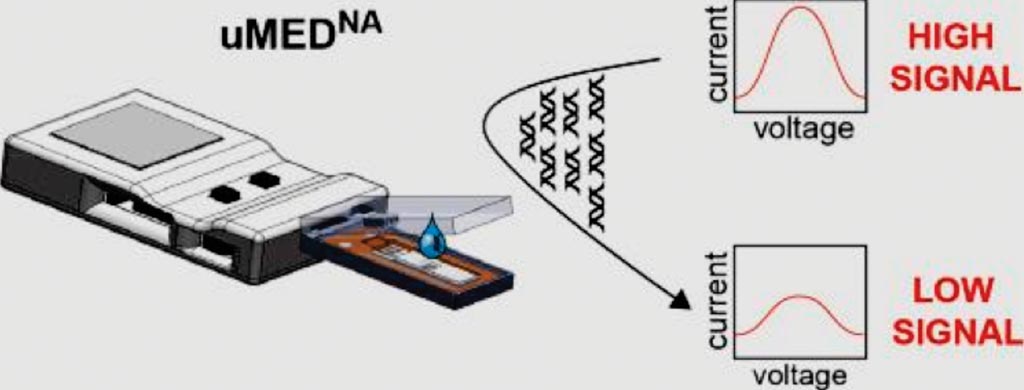Handheld Device Developed for DNA Amplification and Detection
By LabMedica International staff writers
Posted on 23 Jan 2018
A method has been developed that combines electrochemical detection with recombinase polymerase amplification (RPA) on a portable device to improve detection of genetic material from multiple tuberculosis strains.Posted on 23 Jan 2018
The RPA reaction uses enzymes called recombinases that form complexes with oligonucleotide primers and pair the primers with homologous sequences in DNA. A single-stranded DNA binding protein binds to the displaced DNA strand and stabilizes the resulting loop. The primer then initiates DNA amplification by a polymerase, but only if the target DNA sequence is present.

Image: A representation of the portable device uMEDNA for DNA amplification and detection (Photo courtesy of Harvard University).
Scientists from Harvard University (Boston, MA, USA) and Diagnostics for All (Salem, MA, USA) used disposable, paper-based strips that integrate three screen-printed carbon electrodes and accomplish thermoregulation with +/-0.1 ºC temperature accuracy. To detect DNA, the team first prepares the paper test strip that includes the blood sample and primers, in addition to integrated electrodes that contain the reagents for RPA. The test strips allows the team to cut down on reaction volume, reducing reagent cost and blood sample size. After identifying a 213-bp region common to both Mycobacterium tuberculosis and Mycobacterium smegmatis, the team designed appropriate primers for the RPA assay to amplify the specific sequence. Performed at 65 ºC, the assay combined isothermal amplification with electrochemical readout of redox-active hexa-amine ruthenium (III) (Ru(NH3)6]3+) as an electroactive mediator for the electrochemical detection of DNA.
The team also performed the reaction with varying levels of initial concentrations of the M. smegmatis target DNA in order to demonstrate the assay's sensitivity. According to the study, the assay's limit of detection is 0.04 ng/µL, equating to 11 colony forming units (CFU)/mL of M. tuberculosis. Because RPA assays do not need additional sample preparation time, the assay in the study required 20 minutes to identify the biosignal.
The scientists emphasized that the RPA assay could potentially identify the signal faster depending on the type of primer and target sequence. While the team used M. smegmatis as a surrogate strain for M. tuberculosis, the benchtop RPA assay they developed can detect up to 19 Mycobacterium species. In addition, the team also carried out experiments using samples spiked with M. tuberculosis DNA that highlights that the electrochemical method also works with the specific bacterial strain.
Data collected by the device, called uMEDNA, can be transmitted by plugging it into a cell phone's headphone jack. The uMEDNA device also communicates with any bluetooth-enabled device and can link to any computer, tablet, or smartphone. At the moment, scientists have developed software for Apple devices and are currently working on adapting the program for Android devices. Maria-Nefeli Tsaloglou, PhD, the lead author of the study, said, “The uMEDNA device will only cost the end user about USD 30. Introducing the DNA detection paper-based strips will keep the assay price relatively low, as well. Electrochemical analyzers in the lab are bulky, expensive, almost in the range of USD 300,000 to USD 1 million. In this study, we proved that the size and electronics within the analyzer can be cheaper.” The study was published in the February 2018 issue of the journal Analytical Biochemistry.
Related Links:
Harvard University
Diagnostics for All














